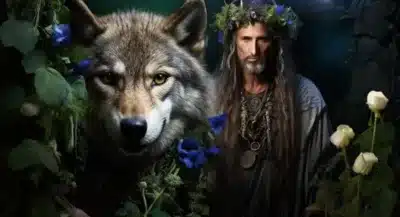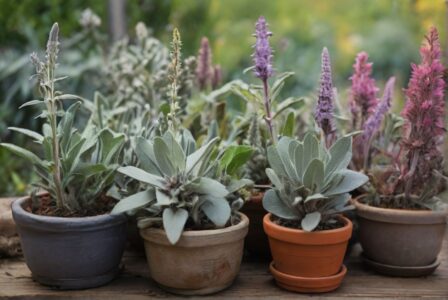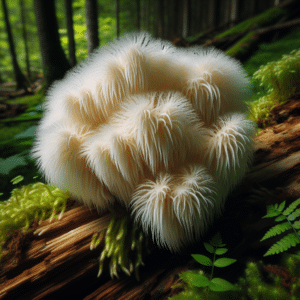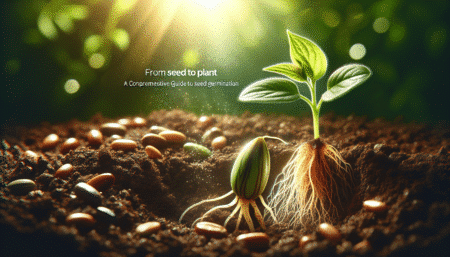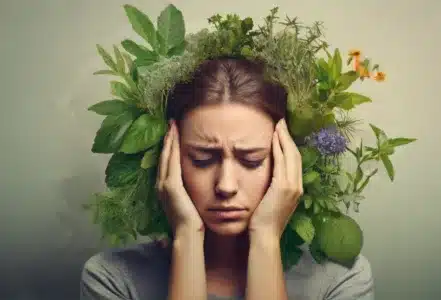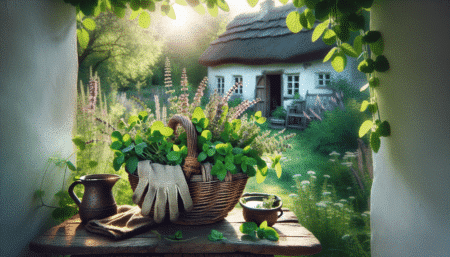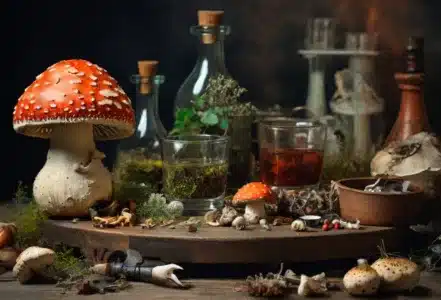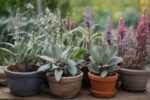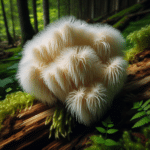- The importance of shamanic plants in Europe
- Elecampane root - a powerful root for shamanic rituals
- Belladonna - The poisonous plant with spiritual properties
- Mugwort - The herb of dreams and visions
- Fly agaric - The mystical mushroom in shamanic use
- Angel's trumpet - The flowery beauty with healing powers
- Datura - The hallucinogenic plant for transcendental journeys
- Monkshood - A dangerous herb with a magical attraction
- Henbane - an ancient medicinal plant for expanding consciousness
- Buckthorn - A fascinating plant from times gone by
Here you can find our Artemisia seeds!
You can find our dried fly agarics here!
Here you can find our Brugmansia seeds!
Here you can find our Datura seeds!
Here you can find our Aconitum seeds!
Here you can find our Hyoscyamus seeds!
Would you like to find out more about the fascinating shamanic plants of Europe? In this blog article, I will introduce you to the 10 best-known plants used by shamans for their healing and spiritual properties. From Ayahuasca to Salvia divinorum - find out exciting information about these plants and discover how they are also available in Germany. Immerse yourself in the world of shamanic plants and be inspired by their power.
1 Introduction: The importance of shamanic plants in Europe
The significance of shamanic plants in Europe is a fascinating topic that captivates many people. These plants have a long history and have been used by shamans for many centuries for various ritual purposes. Although most people immediately think of exotic places such as the Amazon when they hear the term "shamanic plants", there are also a large number of plants with shamanic significance in Europe. In this article, we will look at the 10 best-known shamanic plants in Europe and take a closer look at their spiritual properties. It is important to know that the use of these plants is not without risks and that they should be handled carefully and responsibly.
Information about the various shamanic plants, their effects and possible dangers is therefore essential before engaging with them. Fortunately, there are numerous books, articles and YouTube videos by renowned experts such as Christian Rätsch that provide valuable information about these plants. If you are interested in seeds of these shamanic plants, you can often order them online. There are various suppliers in Germany that offer a wide range of products. When ordering, however, you should pay attention to the availability and ensure that all legal requirements are met. In this article, we will now look at the individual shamanic plants in turn. From the powerful elecampane root to the poisonous belladonna and the hallucinogenic datura, we will explore their properties and possible uses. Immerse yourself in the fascinating world of European shaman plants and discover their magical powers and spiritual meanings.
2. elecampane root - a powerful root for shamanic rituals
The elecampane root is a remarkable plant that plays an important role in shamanic rituals. It is one of the best-known shamanic plants in Europe and is valued for its powerful properties. The root contains various active ingredients that can be used in spiritual practices. With its intense fragrance and energetic effect, it helps to establish a deep connection to the spiritual world. In Germany, products containing elecampane root such as seeds are available both online and in selected stores. For more information on this fascinating plant, it is advisable to consult books or articles on shamanism and herbal medicine. There are also informative videos on YouTube about shamanic plants and their possible uses. When purchasing elecampane root products, you should make sure that they come from reputable suppliers and have been cultivated with care. It is important to note that the use of shaman plants can entail certain risks and should therefore be done responsibly.
3. belladonna - the poisonous plant with spiritual properties
Belladonna, also known as Atropa belladonna, is a poisonous plant with spiritual properties and is one of the best-known shamanic plants in Europe. Its dark purple color and shiny berries make it a striking plant in nature. However, caution is advised, as all parts of deadly nightshade are extremely poisonous and can cause serious damage to health. Despite its toxicity, deadly nightshade is used in shamanic rites and ceremonies as it has a strong psychoactive effect. The alkaloids it contains, such as atropine, have an effect on the central nervous system and can cause hallucinations and altered states of consciousness. In shamanic traditions, belladonna is considered a gateway to the spiritual world and is used for spiritual journeys.
However, it is advisable to inform yourself in detail about the correct dosage and possible risks before use, as improper use can have serious consequences. For more information on shamanic plants in general or belladonna in particular, I recommend books such as "Schamanische Pflanzen - Ratgeber für den richtigen Umgang" by Christian Rätsch or "Die geheimnisvolle Welt der Schamanenpflanzen" by name deutschland. These books provide detailed information on the cultivation, use and traditional applications of various shamanic plants. If you are thinking of growing shaman plants yourself, you can order seeds or plants online from various suppliers such as Amazon or Seeds of Change. However, please note the legal regulations in your country regarding the cultivation and use of shamanic plants. Some plants may fall under the Narcotics Act and unauthorized cultivation or trade may have criminal consequences. Find out in advance about the laws and regulations in your region. Overall, the 10 best-known shamanic plants in Europe offer a fascinating range of spiritual properties and possibilities for shamanic rituals and ceremonies. From elecampane root to buckthorn, there are many interesting plants to discover that have been used by shamans for centuries. Immerse yourself in the world of shamanism and be inspired by the powers of these special plants.
4. mugwort - the herb of dreams and visions
Mugwort is one of the best known shamanic plants in Europe and has a long history in shamanic rites and ceremonies. This herb, also known as Artemisia vulgaris, is prized for its powerful dreamy and visionary properties. Mugwort contains various psychoactive compounds such as thujone, which are responsible for its hallucinogenic effects. Shamans often use mugwort to enter an expanded state of consciousness and experience deep dreams and visions. In shamanic practice, mugwort can be used in various ways. One popular method is to smoke the herb or burn it as incense to create a ritual atmosphere. The smoke of mugwort is believed to clear the energy of space and prepare the mind for spiritual experiences.
Another way to use mugwort is by making a tea from the dried leaves. This tea can be taken before bedtime to induce vivid dreams or drunk during a vision quest. It is recommended to use mugwort with caution and follow the correct dosage as the herb can be potentially toxic. There are numerous books and informative YouTube videos on shamanism and specifically on the use of mugwort as a shamanic plant. A well-known book on the subject is "Shamanic Plants in Europe" by Christian Rätsch. It provides comprehensive information on various shamanic plants and their use in European tradition. If you are interested in mugwort or other shamanic plants, you can order them online. Various dealers offer a wide range of products such as seeds and dried plant parts. However, please note the legal regulations regarding the purchase and use of shaman plants in your country. Mugwort is undoubtedly a fascinating plant with a long history of shamanic use. Its dreamy and visionary properties make it an important tool for shamanic practitioners around the world. If you would like to learn more about mugwort or other shamanic plants, I recommend reading further literature on the subject or watching informative videos.
5. fly agaric - the mystical mushroom in shamanic use
The fly agaric, also known as Amanita muscaria, is one of the most fascinating mushrooms in Europe and plays an important role in shamanic use. This mystical mushroom is often associated with spiritual experiences and transcendental journeys. The distinctive red cap with white dots makes it an unmistakable symbol of the shamanic world. The fly agaric contains psychoactive substances such as muscimol and ibotenic acid, which can alter perception and induce visionary states. In a shamanic context, the fly agaric is often used to induce trance-like states in order to establish contact with the spiritual worlds or to receive visions. Shamans use its powers to support healing processes or to perform rituals in which they interact with the spiritual dimensions. It is important to note that the consumption of fly agaric also carries risks.
The psychoactive substances can cause side effects such as nausea, vomiting and confusion. Therefore, it is crucial that this mushroom is only used under the guidance of experienced shamans or experts. If you want to learn more about the shamanic use of plants, there are numerous books and informative YouTube videos on the subject. Christian Rätsch is a renowned expert in this field and has published several informative books on shamanic plants. A variety of seeds and seeds for shamanic plants are also available online, including fly agaric seeds. Overall, the fly agaric is one of the best-known shamanic plants in Europe. Its mystical properties and connection to the spiritual world make it a fascinating object in shamanic traditions. However, if you are interested in the shamanic use of plants, you should inform yourself thoroughly and only act under the guidance of experienced experts.
6. angel's trumpet - the flowery beauty with healing powers
The angel's trumpet, also known as Brugmansia, is an impressive shaman plant with floral beauty and healing powers. Its large trumpet-shaped flowers in various colors such as white, yellow or pink not only attract attention, but are also valued for their medicinal properties. The plant contains various alkaloids such as scopolamine and hyoscyamine, which can have pain-relieving and calming effects. In shamanic rites, the angel's trumpet was traditionally used to achieve changes in consciousness.
By inhaling the scent of the flowers or drinking a tea made from the leaves, shamans were able to undertake spiritual journeys and make contact with higher planes. However, it is important to note that the angel's trumpet contains poisonous substances and should therefore only be used under expert guidance. Overall, it is one of the most fascinating shamanic plants in Europe and is appreciated by both amateur gardeners and those interested in spirituality. If you want to find out more about this flowery beauty, you can find a wealth of information in books or on YouTube channels by renowned experts such as Christian Rätsch. Some online stores even offer seeds for growing your own, so you can experience the angel's trumpet for yourself.
7 Datura - The hallucinogenic plant for transcendental journeys
The datura plant, also known as Datura, is one of the most fascinating shamanic plants in Europe. With its hallucinogenic properties, it enables transcendental journeys into other states of consciousness. Datura contains various psychoactive substances such as scopolamine, atropine and hyoscyamine, which can have a powerful effect on the mind. It is often used in shamanic rituals for vision quests or to make contact with the spiritual realm. However, it is important to note that the use of datura is not without risks and should be supervised by experienced people. For those interested, the author Christian Rätsch offers extensive information on shamanic plants in his books and articles. His products are available on platforms such as Amazon and offer valuable knowledge for anyone who wants to delve deeper into this topic. There are also informative videos on YouTube about shamanism and especially about the use of shamanic plants.
It is important to emphasize that the handling of such plants should be done responsibly. Comprehensive research and seeking professional advice are essential in order to minimize potential dangers and derive the greatest possible benefit from these transcendent experiences. In Germany, it is also possible to legally purchase seeds from certain shamanic plants. However, the legal provisions and regulations should always be observed. Such products are often shipped discreetly and quickly. The datura plant is undoubtedly one of the most interesting shamanic plants in Europe, making it possible to gain new insights through transcendental journeys. However, its hallucinogenic properties cannot be underestimated, which is why responsible handling is of the utmost importance. With the right knowledge and the necessary caution, the experience with the datura plant can lead to a profound spiritual journey.
8 Aconite - A dangerous herb with a magical attraction
Monkshood, also known as Aconitum, is one of the most dangerous shamanic plants in Europe. Its magical attraction and at the same time toxic nature make it a fascinating plant in shamanic circles. Monkshood contains highly toxic alkaloids such as aconitine, which can be life-threatening if handled incorrectly. Nevertheless, this plant exerts a strong fascination on many people who are interested in shamanic practices. The Amazon offers a variety of products related to shamanic plants, including aconite seeds. However, it is important to note that the purchase and use of this plant is subject to strict legal regulations in Germany. Christian Rätsch, a renowned expert on shamanic plants, has published informative books and articles on the subject. If you are looking for more information about aconite or other shamanic plants, you can find informative videos on YouTube. However, please be careful and inform yourself thoroughly about possible risks and precautions when handling these special plants.
9. henbane - an ancient medicinal plant for expanding consciousness
Henbane, also known as Hyoscyamus niger, is an ancient medicinal plant with fascinating properties for expanding consciousness. Henbane should not be missing from the list of the 10 best-known shamanic plants in Europe. This plant has a long history in shamanic rites and has been used by shamans for spiritual purposes for centuries. Henbane contains psychoactive substances such as scopolamine and hyoscyamine, which can lead to hallucinogenic effects. These active ingredients have the ability to expand consciousness and induce transcendental experiences. There are various ways to use henbane. One common method is to make a tea from the dried leaves or seeds of the plant. This tea can then be taken during shamanic ceremonies to achieve an altered state of consciousness. However, it is important to note that henbane should be used with caution due to its strong effects.
There are several books and information available on henbane and its use as a shamanic plant. The renowned ethnopharmacologist Christian Rätsch, for example, has published several articles and books on shamanic plants, including henbane. Products such as henbane seeds are available on platforms such as Amazon to grow it yourself. However, it is important to note that the cultivation and use of henbane may be subject to legal restrictions in some countries. Overall, henbane is a fascinating plant with a long history in shamanic practice. Its mind-expanding properties make it an important ingredient in shamanic rituals and ceremonies. If you would like to learn more about shamanic plants, I recommend that you take a look at further information or read relevant books by experts such as Christian Rätsch.
10.buckthorn - a fascinating plant from times gone by
Buckthorn, also known as Rhamnus cathartica, is a fascinating plant from times gone by and is one of the 10 best-known shamanic plants in Europe. The buckthorn is a plant native to Germany and was used by our ancestors for various purposes. For example, its berries were used to make dyes and its bark was used in traditional medicine. Today, you can find a wealth of information about buckthorn in books, articles and even on YouTube.
Buckthorn seeds are available online and can be ordered easily. There are various suppliers who offer products such as seeds or plants. Christian Rätsch is a renowned expert in the field of shaman plants and has also published information about buckthorn. Shipping is usually fast and reliable, so that you can receive the desired products promptly. When ordering, however, care should be taken to ensure that all legal regulations are complied with, especially when purchasing seeds or other plant products. Overall, buckthorn is an extremely interesting plant with a long history in Europe. Its importance as a shamanic plant should not be underestimated as it gives us an insight into past times and their spiritual practices. If you would like to learn more about this fascinating plant, I recommend that you look further into the subject and explore the wide range of information and products available on buckthorn.
Further questions and answers on the subject of shaman plants and magic plants
What are shaman plants?
Shamanic plants are plants used by shamans in various cultures around the world for spiritual and medicinal purposes. These plants often contain psychoactive substances that alter the shaman's state of consciousness and enable them to travel to other dimensions or spiritual worlds. One well-known shaman plant, for example, is the ayahuasca bush from the Amazon region. The active ingredients it contains, such as DMT (dimethyltryptamine), enable deep spiritual experiences and visions. In many indigenous cultures, ayahuasca is used in healing ceremonies. Another important shamanic plant is the peyote cactus, which is used by North American Indians.
The cactus contains the hallucinogen mescaline and is used as a sacramental remedy in religious ceremonies. Psilocybin mushrooms, also known as magic mushrooms, are also shamanic plants. They contain psychoactive substances such as psilocybin and psilocin and have been used for centuries by indigenous peoples for ritual purposes. Finally, there are numerous other plants such as San Pedro cacti, iboga roots or sage that are used in shamanic practices. Each of these plants has its own specific properties and effects on consciousness. Overall, shamanic plants are important tools for shamans to gain spiritual insights, promote healing and communicate with the spiritual world. However, they are traditionally used in ritual contexts and under the guidance of experienced shamans, as they can have potentially powerful effects.
What do shamans drink?
Shamans drink various substances for spiritual purposes. One commonly used substance is ayahuasca, a herbal mixture from the Amazon region. Ayahuasca contains DMT (dimethyltryptamine), which has a hallucinogenic effect and puts the shaman in an altered state of consciousness. This enables them to travel to other dimensions and gain spiritual insights. Another substance drunk by shamans is peyote. Peyote is a cactus that contains the hallucinogen mescaline. The consumption of peyote leads to visions and spiritual experiences. In some cultures, shamans also drink certain herbal teas or infusions.
These often contain psychoactive plants such as iboga or mushrooms containing psilocybin. These substances are used to gain access to spiritual worlds and support healing processes. It is important to note that for shamans, the use of such substances is part of their religious or spiritual practice and takes place under certain ritual conditions. The use of these substances requires a deep understanding of the tradition and experience in handling them. The choice of drinks depends on the individual preferences of the shaman as well as the cultural traditions in which they practice. The consumption of these substances is always done with the aim of strengthening the connection to the spiritual world and gaining spiritual insights.
Further links and book recommendations
- https://www.hanf-magazin.com/drogenkunde/schamanenpflanzen/
- https://www.storl.de/artikel/schamanenpflanzen-was-koennen-wir-von-ihnen-lernen/
- https://www.amazon.de/Meine-Begegnungen-Schamanenpflanzen-Christian-R%C3%A4tsch/dp/3038004391/ref=cm_cr_arp_d_product_top?ie=UTF8
YouTube
Wolf Dieter Storl - European shaman plants - what can we learn from them?
Note: The information in this article is for informational purposes only and is not intended to replace the advice of a physician or other healthcare professional. Always consult a doctor before using any new herbs or supplements. Furthermore, you should always check whether the cultivation/possession/use/processing of certain plants is permitted in your country. As we only offer ornamental plants in our store, we are allowed to only Provide information and advice on the correct care of plants!

